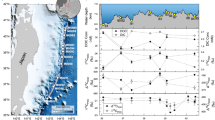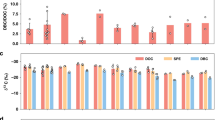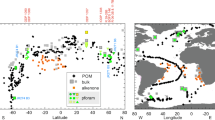Abstract
The origin of dissolved organic carbon (DOC) in the ocean has been long debated. Whereas Mantoura and Woodward1 have used the conservative nature of DOC in a British estuary to conclude that ≥50% of DOC in the oceans could be river-derived, recent lignin results in the equatorial Pacific2 have indicated that ≤10% of the DOC is potentially of terrestrial origin. In addition, the δ13C signature (relative to the PDB standard) of DOC ranges from –20 to –24‰ (refs 3,4), indicating that the primary source of DOC is from marine-derived organic carbon. Here we present the first detailed profile of radiocarbon measured in DOC and dissolved inorganic carbon (DIC) in the oligotrophic gyre of the central North Pacific. δ14C (per mil deviation from the activity of 19th-century wood) of DOC ranged from –150‰ (1,310 yr BP) in surface waters to –540‰ (6,240 yr BP) at 5,710 m, 40 m off the bottom, where these 'apparent ages' or 'residence times' are mean values for the combined constituents of the DOC. The surprising similarity in the shapes of the profiles of δ14C in the DOC and DIC pools suggests that similar processes are controlling the radiocarbon distribution in each of the two reservoirs and that bomb-produced radiocarbon has penetrated the DOC + DIC pools to a depth of ˜900 m. The depletion of the δ14C DOC values by 300‰ with respect to the δ14C DIC values suggests that a certain fraction of the DOC is recycled within the ocean on longer time-scales than DIC.
This is a preview of subscription content, access via your institution
Access options
Subscribe to this journal
Receive 51 print issues and online access
$199.00 per year
only $3.90 per issue
Buy this article
- Purchase on SpringerLink
- Instant access to full article PDF
Prices may be subject to local taxes which are calculated during checkout
Similar content being viewed by others
References
1. Mantoura, R. F. C. & Woodward, E. M. S. Geochim. cosmochim. Acta 47, 1293-1309 (1984). 2. Meyers-Schulte, K. J. & Hedges, J. I. Nature 321, 61-63 (1986). 3. Williams, P. M. & Gordon, L. I. Deep-Sea Res. 17, 19-27 (1970). 4. Eadie, B. J., Jeffrey, L. M. & Sackett, W. M. Geochim. cosmochim. Acta 42,1265-1269 (1978). 5. Williams, P. M., Oeschger, H. & Kinney, P. Nature 224, 256-258 (1969). 6. Linick, T. W. Radiocarbon 28, 559-607 (1980). 7. Jull, A. J. T., Donahue, D. J., Hathaway, A. L., Linick, T. W. & Toolin, L. J. Radiocarbon 28, 191-197 (1986). 8. Ostlund, H. G. & Stuiver, M. Radiocarbon 22, 25-40 (1980). 9. Williams, P. M., Stenhouse, M. C., Dmffel, E. M. & Koide, M. Nature 265, 698-701 (1978). 10. Williams, P. M., Carlucci, A. F. & Olson, R. Oceanologica Acta 3, 471-476 (1980). 11. Barber, R. T. Nature 220, 274-275 (1968). 12. Williams, P. M. & Carlucci, A. F. Nature 262, 810-811 (1976). 13. Lindroth, P. & Mopper, K. Analyt. Chem. 51, 1667-1674 (1979). 14. Burney, C. M. & Sieburth, J. McN. Mar. Chem. 5, 15-28 (1977). 15. Stuermer, D. H. & Harvey, G. R. Nature 250, 480-481 (1976). 16. Gagosian, R. B. & Stuermer, D. H. Mar. Chem. 5, 605-632 (1977). 17. Williams, P. M. / Fish. Res. Bd Canada 22, 1107-1122 (1965). 18. Kennicut II, M. C. & Jeffrey, L. M. Mar. Chem. 10, 367-387 (1981). 19. Broecker, W. S. Chemical Oceanography (Harcourt, Brace, Jovanovich, New York, 1974). 20. Stuiver, M., Quay, P. D. & Ostlund, H. G. Science 219, 849-854 (1983). 21. Druffel, E. M., Williams, P. M., Livingston, H. & Koide, M. Earth planet. Sci. Lett. 71, 205-214 (1984). 22. Jahnke, R. A. & Jackson, G. A. Nature 329, 621-623 (1987). 23. Jackson, G. A. & Williams, P. M. Deep-Sea Res. 31, 223-235 (1985). 24. Martin, J. H., Knauer, G. A., Karl, D. M. & Broenkow, W. W. Deep-Sea Res. 34, 267-287 (1987). 25. Jenkins, W. J. Nature 300, 246-248 (1982). 26. Sverdrup, H. U., Johnson, M. W. & Fleming, R. H. The Oceans (Prentice-Hall, New York, 1942). 27. Pace, M. L., Knauer, G. A., Karl, D. M. & Martin, J. H. Nature 325, 803-804 (1987). 28. Meybeck, M. Am. J. Sci. 282, 401-450 (1982). 29. Hedges, J. I. et al. Science 231, 1129-1131 (1986). 30. Stuiver, M. & Polach, H. Radiocarbon 19, 355-363 (1977). 31. Craig, H., Broecker, W. S. & Spencer, D. GEOSECS Pacific Expeditions Vol. 4 (NSF, Washington DC, 1981).
Author information
Authors and Affiliations
Rights and permissions
About this article
Cite this article
Williams, P., Druffel, E. Radiocarbon in dissolved organic matter in the central North Pacific Ocean. Nature 330, 246–248 (1987). https://doi.org/10.1038/330246a0
Received:
Accepted:
Issue Date:
DOI: https://doi.org/10.1038/330246a0
This article is cited by
-
Radiocarbon dating
Nature Reviews Methods Primers (2021)
-
Enigmatic persistence of dissolved organic matter in the ocean
Nature Reviews Earth & Environment (2021)
-
A call for refining the role of humic-like substances in the oceanic iron cycle
Scientific Reports (2020)
-
Removal of Refractory Dissolved Organic Carbon in the Amundsen Sea, Antarctica
Scientific Reports (2020)
-
Abiotic synthesis of graphite in hydrothermal vents
Nature Communications (2019)



